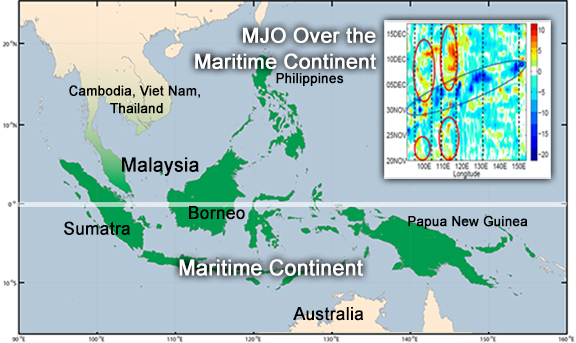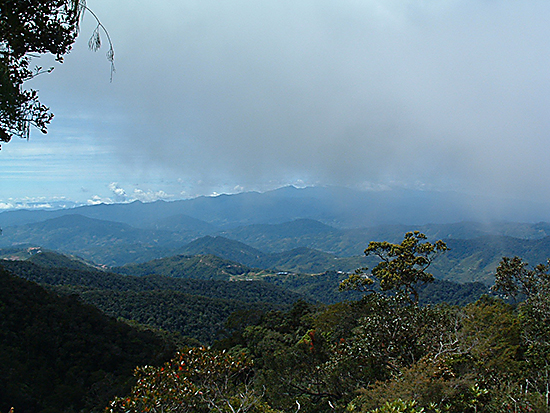Daily cycle of cloudiness over Maritime Continent disrupts the Madden-Julian Oscillation
Submitter:
Hagos, Samson M — Pacific Northwest National Laboratory
Area of research:
Radiation Processes
Journal Reference:
Science
Every month or two, a large complex of clouds forms over the Indian Ocean and moves eastward, a pattern known as the Madden-Julian Oscillation (MJO). The MJO exhibits hard-to-predict behaviors, often weakening, as it moves across the Maritime Continent (MC; Indonesia-Malaysia and New Guinea)—so-called because of its combination of shallow seas and scattered land masses. Scientists used high-resolution regional model simulations and analysis of ground and satellite measurements to find that daily weather patterns, or the diurnal cycle, over the MC are a key factor in disrupting the MJO.
Impact
The MJO affects weather and climate all around the world, including tropical cyclone development in the Pacific and Atlantic Oceans and precipitation over western North America. Better predictions of the MJO would help in preparing for its impacts. This study opens the door to understanding why some MJO episodes cross the Maritime Continent while others do not, and provides potential insight into why many global models (with poor consideration of the diurnal cycle) fail to capture observed MJO behavior over the MC.
Summary
Department of Energy (DOE) scientists at Pacific Northwest National Laboratory performed simulations of the November, 2011 MJO episode using a pair of ensembles of control (CONTROL) and no-diurnal cycle (NODC) simulations. In the CONTROL simulations, the MJO signal weakened as it propagated across the MC, with much of the convection stalling over the large islands of Sumatra and Borneo. In the NODC simulations, where the incoming shortwave radiation (energy from the sun) at the top of the atmosphere was maintained at its daily mean value, they found that the MJO convection signal propagated across the MC comparatively unaffected. Even though the mean incoming shortwave radiation at the top of the atmosphere was the same in both cases, the mean amount reaching the surface over the islands was larger in the CONTROL than in the NODC ensemble. The researchers found that in the presence of the solar diurnal cycle, cloudiness peaks well after the peak downwelling shortwave radiation (local noon), giving plenty of time for the surface to receive a large amount of solar radiation under relatively clear-sky conditions. Using observations from the Atmospheric Radiation Measurement Climate Research Facility, a DOE user facility, and the Tropical Rainfall Measuring Mission, the scientists found that ahead of and behind the MJO active phase, the diurnal cycle of cloudiness enhanced downwelling shortwave radiation and hence convection over the MC islands. This enhanced stationary convection competed with and disrupted the convective signal of MJO events that propagate over the waters surrounding the islands.



